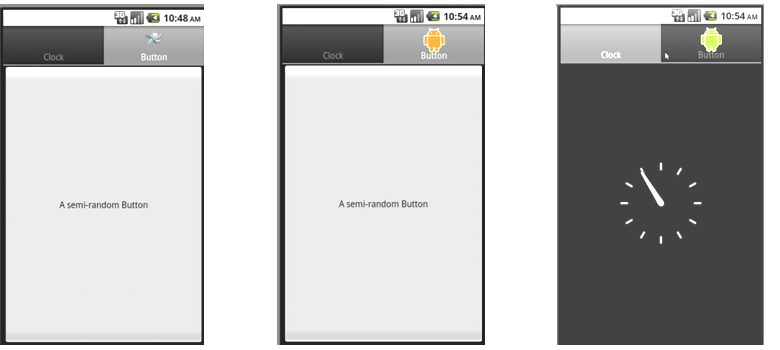在手机屏幕中,Tab也是比较常用的,通常和List结合,例如我们手机的通信录。下面是Tag的结构。
TabHost是整个Tab的容器,包括两部分,TabWidget和FrameLayout。TabWidget就是每个tab的标签,FrameLayout则是tab内容。
如果我们使用extends TabAcitivty,如同ListActivity,TabHost必须设置为@android:id/tabhost
TabWidget必须设置android:id为@android:id/tabs
FrameLayout需要设置android:id为@android:id/tabcontent
例子一:基本的Tag例子
1)Android XML文件
<?xml version="1.0" encoding="utf-8"?> <TabHost xmlns:android="http://schemas.android.com/apk/res/android" android:id="@+id/c92_tabhost" android:layout_width="fill_parent" android:layout_height="fill_parent"> <LinearLayout android:orientation="vertical" android:layout_width="fill_parent" android:layout_height="fill_parent"> <TabWidget android:id="@android:id/tabs" android:layout_width="fill_parent" android:layout_height="wrap_content" /> <FrameLayout android:id="@android:id/tabcontent" android:layout_width="fill_parent" android:layout_height="fill_parent"> <AnalogClock android:id="@+id/c92_tab1" android:layout_width="fill_parent" android:layout_height="fill_parent" android:layout_centerHorizontal="true" /> <Button android:id="@+id/c92_tab2" android:layout_width="fill_parent" android:layout_height="fill_parent" android:text="A semi-random Button" /> </FrameLayout> </LinearLayout> </TabHost>
2)源代码
protected void onCreate(Bundle savedInstanceState) { super.onCreate(savedInstanceState); setContentView(R.layout.chapter_9_test2); //步骤1:获得TabHost的对象,并进行初始化setup() TabHost tabs = (TabHost)findViewById(R.id.c92_tabhost); tabs.setup(); //步骤2:通过TabHost.TabSpec增加tab的一页,通过setContent()增加内容,通过setIndicator增加页的标签 /*(1)增加第1页*/ TabHost.TabSpec spec = tabs.newTabSpec("Tag1"); spec.setContent(R.id.c92_tab1); spec.setIndicator("Clock"); tabs.addTab(spec); /*(2)增加第2页*/ spec = tabs.newTabSpec("Tag2"); spec.setContent(R.id.c92_tab2); spec.setIndicator("Button"); tabs.addTab(spec); //步骤3:可通过setCurrentTab(index)指定显示的页,从0开始计算。 tabs.setCurrentTab(1); }
例子二:设置标签
标签设置除了上面给出文本外,还可以给出widget,例如:
Button b = new Button(this); b.setText("标签"); spec.setIndicator(b);
这也是work的,当然设置button是很无聊的,通常我们希望是图片,如下面三图:

1)我们在标签上加一个图标,如左图。这个图片存在于drawable/目录下:
Resources res = getResources();
spec.setIndicator("Button",res.getDrawable(R.drawable.star_logo));
2)我们在标签上家一个图片,当用户选择该页是为某一图标,不选择时为另一图标。如上中图和右图所示。我们在drawable目录项目有相关的两个图片文件。会议在Android学习笔记(六):xml和widget中的View,我们建立一个XML文件,描述:
<?xml version="1.0" encoding="utf-8"?>
<selector xmlns:android="http://schemas.android.com/apk/res/android">
<!-- 这是顺序执行的,如果状态是selected,则为android_focused图标,如果不是下一步,采用android_normal图标-->
<item android:drawable="@drawable/android_focused"
android:state_selected="true" />
<item android:drawable="@drawable/android_normal" />
</selector>
这个文件我们取名为chapter_9_tutorial3_ic.xml,为了方便管理,这次我们没有将之放置在layout目录下,而是方式在drawable目录下。源代码如下:
Resources res = getResources();
spec.setIndicator("Button",res.getDrawable(R.drawable.chapter_9_tutorial3_ic));
例子三:动态添加Tab页
在某些情况下,我们需要动态添加Tab页,可通过TabContentFactory来实现。下面的例子,我们点击Tab也中的button,将新增一个tab页。
Button button = (Button)findViewById(R.id.c92_tabhost); button.setOnClickListener(new View.OnClickListener() { public void onClick(View arg0) { TabHost.TabSpec spec = tabs.newTabSpec("tag1"); spec.setContent(new TabHost.TabContentFactory() { /*createTabContent将返回View,这里我们简单用一个模拟时钟*/ public View createTabContent(String tag) { return new AnalogClock(Chapter9Test3.this); } }); spec.setIndicator("Clock"); tabs.addTab(spec); } });
例子四:将一个Activity加入到Tab页
在Android SDK的Tutorial中给出了一个例子,采用setContent(Intent intent)的方式在content中传递一个Activity。这个例子费了我比长的时间,因为一开始运行时都报错。因此在写的时候,注意下面两个问题:
- 采用setContent(Intent intent)之前,必须对TabHost进行setup (LocalActivityManager activityGroup),因为在调起acivity时需要activityGroup,如果我们继承TabActivity,则由TabAcitivty自动完成,鉴于我们目前对LocalActivityManager尚不了解,简单地可以直接继承TabActivity
- Activity不能是内部类,Activity必须在AndroidManifest中进行注册
对于对第1点,我们的XML文件如下:
<?xml version="1.0" encoding="utf-8"?> <TabHost xmlns:android="http://schemas.android.com/apk/res/android" android:id="@android:id/tabhost" android:layout_width="fill_parent" android:layout_height="fill_parent"> <LinearLayout android:orientation="vertical" android:layout_width="fill_parent" android:layout_height="fill_parent" android:padding="5dp"> <TabWidget android:id="@android:id/tabs" android:layout_width="fill_parent" android:layout_height="wrap_content" /> <FrameLayout android:id="@android:id/tabcontent" android:layout_width="fill_parent" android:layout_height="fill_parent" android:padding="5dp"> </FrameLayout> </LinearLayout> </TabHost>
对于第2点要求,我们可以直接使用之前我们创建过的Activity,代码如下
public class Chapter9Tutorial3 extends TabActivity{ protected void onCreate(Bundle savedInstanceState) { super.onCreate(savedInstanceState); setContentView(R.layout.chapter_9_tutorial3); TabHost tabs = getTabHost(); TabHost.TabSpec spec = null; //通过Intent,将activity导入,对于intent,这个类不能是内部类,这个类必须在AndroidManifest中注册的类 Intent intent = new Intent(); intent.setClass(this, Chapter9Tutorial2.class); spec = tabs.newTabSpec("Tag1"); spec.setIndicator("Intent"); spec.setContent(intent); tabs.addTab(spec); . .. ... } }
转载自:http://blog.csdn.net/flowingflying/article/details/6304289,更多内容请看我的Andriod开发相关文章